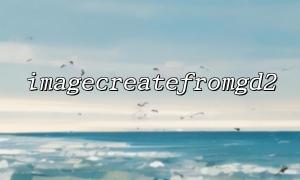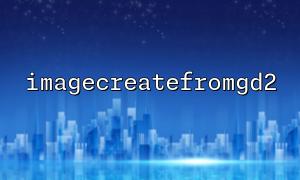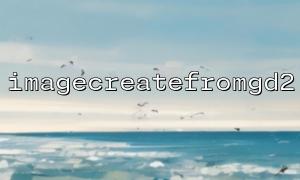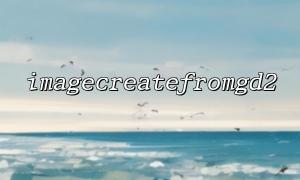In website development, optimizing image loading speed is a very important task. Images usually take up a lot of bandwidth. If they are not loaded quickly enough, it may lead to a decline in user experience and even affect SEO ranking. In PHP, using the GD library for image processing is a common practice. In this article, we will focus on how to use the imagecreatefromgd2() function to convert GD2 images into compressed format, thereby optimizing the loading speed of website images.
GD2 is an image file format that is usually used in the GD image processing library. It usually has a smaller file size than other common image formats such as JPEG or PNG. GD2 format images can be processed and operated through PHP's GD library.
The loading speed of the website has a direct impact on the user experience. If the website's image loading is slow, it may cause the user to leave while waiting, which will lead to an increase in bounce rate. Therefore, by optimizing the image, the size of the image can be reduced, the loading speed can be improved, and bandwidth can be saved.
In PHP, the imagecreatefromgd2() function is used to load image files in GD2 format. This function converts the image into a GD image resource, and then you can process the image, such as cropping, resizing, or compressing.
<?php
// loadGD2image
$image = imagecreatefromgd2('example_image.gd2');
// 检查是否成功load
if (!$image) {
die("无法loadGD2image");
}
// 输出image的类型
header('Content-Type: image/jpeg');
// 将imageConvert toJPEGFormat and compress
imagejpeg($image, null, 75); // 75For compression quality(0-100)
// Free memory
imagedestroy($image);
?>
In the above example code, the imagecreatefromgd2() function loads an image file in GD2 format and converts it to a PHP image resource. Next, use the imagejpeg() function to convert the image to JPEG format and set the compression quality to 75 (between 0-100, the smaller the value, the stronger the compression). Finally, use imagedestroy() to release the image resource.
Image compression is crucial to optimizing website image loading speed. With proper compression, we can reduce the size of the image file, thereby speeding up the loading process. Functions such as imagejpeg() , imagepng() and imagegif() all support compression functions.
imagejpeg($image, $filename, $quality) : Compress the image to the specified quality. The quality parameter is an integer from 0 to 100. The higher the value, the better the image quality and the larger the file size. Generally speaking, a good balance can be achieved by setting the mass to 75.
In image optimization, JPEG is usually suitable for photo-like images, while PNG is suitable for images with transparent backgrounds. For GD2 images, if the goal is to optimize loading speed, it can be converted to JPEG or PNG format.
If you have a lot of images to work with, consider writing a script to batch process the image, converting it from GD2 format to compressed JPEG format. Here is a simple batch processing example:
<?php
// Get all the contents in the specified directoryGD2image文件
$images = glob('images/*.gd2');
foreach ($images as $imageFile) {
// loadGD2image
$image = imagecreatefromgd2($imageFile);
// Set the target file name,Convert toJPEGFormat
$outputFile = str_replace('.gd2', '.jpg', $imageFile);
// Compress and save asJPEGFormat
imagejpeg($image, $outputFile, 75); // 75For compression quality
// Free memory
imagedestroy($image);
}
?>
This script will scan all GD2 image files in the images directory, convert them to JPEG format, compress them and save them as a new file.
By using PHP's imagecreatefromgd2() function, we can easily load and convert GD2 images into compressed format, thus effectively optimizing the website's image loading speed. Reasonably compressing and converting images can not only improve the user experience, but also have a positive impact on search engine optimization (SEO). Therefore, understanding how to process and optimize images is an important skill that every web developer should master.















